Art Lovers discussion
Questions from the Met
 Carol wrote: "My painting teachers would never let us buy black paint -- always make your own black.
Carol wrote: "My painting teachers would never let us buy black paint -- always make your own black.Mark Rothko, No. 2, mixed media on canvas
"
I saw a room of Rothko's black paintings at the Nat'l Gallery a few weeks ago.
 John wrote: "It's not terribly sophisticated. It seems more than anything else to be the work of a high school student who just might be a little overzealous ..."
John wrote: "It's not terribly sophisticated. It seems more than anything else to be the work of a high school student who just might be a little overzealous ..."Did he make this in high school? The date on it is 1987 -- he was 37.
A Catholic placing a crucifix in a container of his urine.
Was his only intention to shock people?
Or was he making a statement?
 How was it to be in a room full of Rothko's black artworks?
How was it to be in a room full of Rothko's black artworks?Did you get a chance to see the "Pre Raphaelite Lens --photography & painting from 1848-1845? It closes on Jan. 30th. It looked interesting.
Artworks from the National Gallery & Musee d'Orsay
 Carol, I completely misunderstood what you were asking me. You were perfectly clear, but I was having a blond moment.
Carol, I completely misunderstood what you were asking me. You were perfectly clear, but I was having a blond moment. Of course, you were asking me about the value of Serrano's "Piss Christ," not the high school student's work. I like the Serrano because it manages to startle most everyone, but I never saw it as being so-called "shock art." Like all good art, it cleaves open a wonderfully wide interpretive space and asks more questions than it provides answers. Most people take it to be somehow anti-religious in its message. That might be the way he intended it, but it's never the way I read it. I saw him trying to say, "Look, this is what we do to Christ. In giving him idle praise with our words, we fail to do the same in our actions, and therefore we disrespect both his message and his life," or something along those lines. I took "Piss Christ" to be an indictment of middle-class, "easy" religion - the type of religion that coddles and ensures and comforts, instead of the kind that makes you selfless, existentially aware, uncertain. That's why it has value to me.
 wow, John! I never thought of "Piss Christ" that way. At first, I was offended thinking it was anti-religious or at least some sort of blasphemy. But I completely see where you are coming from in a new light. I don't know how he intended it, but as in all art, it is what we make of it.
wow, John! I never thought of "Piss Christ" that way. At first, I was offended thinking it was anti-religious or at least some sort of blasphemy. But I completely see where you are coming from in a new light. I don't know how he intended it, but as in all art, it is what we make of it.
 Carol wrote: "How was it to be in a room full of Rothko's black artworks?
Carol wrote: "How was it to be in a room full of Rothko's black artworks?Did you get a chance to see the "Pre Raphaelite Lens --photography & painting from 1848-1845? It closes on Jan. 30th. It looked interest..."
I like Rothko, although I don't find his black paintings quite as compelling as his colored ones. I was pressed for time and had to walk through the room in about 4 minutes, so it was good the exhibit was small. They had music playing which I believe also plays in the Rothko Chapel in Houston. (Maybe the black paintings are from the Rothko Chapel? I have the brochure but have not read it yet.)
I didn't see the Pre Raphaelite Lens exhibit. I did see a wonderful exhibit of drawings from some German (I think) collection whose name completely escapes me now. I see that the exhibit has ended but the NGA website only lists past exhibits through 2007, which is frustrating. The exhibit included a couple Caspar David Friedrich drawings that were stunning. I can't remember if this was one of them, but they were similar to this:
[image error]
 Thanks John.
Thanks John. I agree with your interpretation above and have come to that conclusion after some time. But my opinion is that part of his intention was shock (due to his medium of choice) and, as a former Catholic, I feel that he was also making a statement on idolatry.
 Carol wrote: "Thanks John.
Carol wrote: "Thanks John. I agree with your interpretation above and have come to that conclusion after some time. But my opinion is that part of his intention was shock (due to his medium of choice) and, as ..."
Seranno's a disturbing and interesting artist. His subjects tend to be those which are visceral (bodily fluids) and images that have a strong emotional content. If you are curious about this artist, you can read his page on artnet, including a good selection of his work. Note that I am attaching this with a content advisory; not graphic like say, Maplethorpe, but some subject matter is disturbing...
 Back to symbolism, though. I think that symbols that work best in the visual arts are often ones where the visual quality of the symbols evoke something of the mood they portray.
Back to symbolism, though. I think that symbols that work best in the visual arts are often ones where the visual quality of the symbols evoke something of the mood they portray.That doesn't mean that you can't double up on symbols and create ambiguity. In a representational painting you can add multiple symbolic objects; in an abstract one, you can introduce an abstract shape that can serve as multiple symbols, which can evoke a mystery.
[image error]
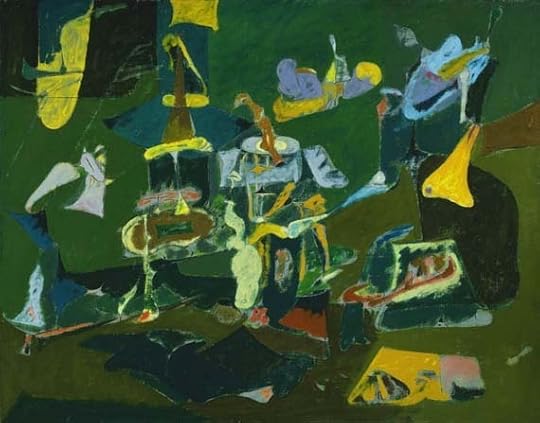
 Ed wrote: "As a rather subversive exercise, let me include a particular work (Don't peek at the image URL). And the question is--not is this the finest piece of art that you have ever seen... ...is this art...."
Ed wrote: "As a rather subversive exercise, let me include a particular work (Don't peek at the image URL). And the question is--not is this the finest piece of art that you have ever seen... ...is this art...."No takers? Anybody figure it out?
 That's not an image I've seen of John the Baptist before but it looks like a drunken jumble of musical and drawing implements on the floor. I can't tell if it's armor or boots on my little laptop but its Caravaggio's representation of a gay old time. I'm not saying it's John the Baptist either, just that I recognize his model jumping off the bed to play? The second image could be a musical sauce, too.
That's not an image I've seen of John the Baptist before but it looks like a drunken jumble of musical and drawing implements on the floor. I can't tell if it's armor or boots on my little laptop but its Caravaggio's representation of a gay old time. I'm not saying it's John the Baptist either, just that I recognize his model jumping off the bed to play? The second image could be a musical sauce, too.
 It is taken to be "Love Conquers All", and the cupid is triumphant over music, the arts and sciences.
It is taken to be "Love Conquers All", and the cupid is triumphant over music, the arts and sciences. Here's an excerpt from Wikipedia: "The painting illustrates the line from Virgil's Eclogues X.69, Omnia vincit amor et nos cedamus amori ("Love conquers all; let us all yield to love!"). A musical manuscript on the floor shows a large "V". It has therefore been suggested also that the picture is a coded reference to the attainments of Vincenzo Giustiniani: his Genoese family ruled Chios (until the island's capture by the Turks) in 1622, hence the coronet; the cultivated Marchese also wrote about music and painting (pen, manuscript and musical instruments), was constructing an imposing new palazzo (geometrical instruments), studied astronomy (astral sphere), and was praised for his military prowess (armour). The symbology thus holds the possible reading: Vincenzo Conquers All. Giustiniani is said to have prized it above all other works in his collection"
Now the other one is a Gorky, and invokes nature in a general way, even though the particular aspects of nature are overlaid (milkweed, grass, trees, leaves, flowers) in a way that prevents any form from having one definitive reading.
 Ed wrote: "Ed wrote: "As a rather subversive exercise, let me include a particular work (Don't peek at the image URL). And the question is--not is this the finest piece of art that you have ever seen... ......"
Ed wrote: "Ed wrote: "As a rather subversive exercise, let me include a particular work (Don't peek at the image URL). And the question is--not is this the finest piece of art that you have ever seen... ......"Answers tomorrow.....
 Beautiful Ed. I appreciate having the symbolism explained. It was hard to make out on my small lap top. I enjoy symbolic quizzes...that's why I like Piero di Cosimo's paintings, and mannerism in general. But, with Love Conquers All, I can't help but see Caravaggio's explicit predilection for young boys, especially for this young model. If he were alive I wouldn't let my nephew anywhere near him!
Beautiful Ed. I appreciate having the symbolism explained. It was hard to make out on my small lap top. I enjoy symbolic quizzes...that's why I like Piero di Cosimo's paintings, and mannerism in general. But, with Love Conquers All, I can't help but see Caravaggio's explicit predilection for young boys, especially for this young model. If he were alive I wouldn't let my nephew anywhere near him!
 I certainly agree that there is a significant homoerotic aspect to Caravaggio's work, although some revisionist historians tend to downplay it.
I certainly agree that there is a significant homoerotic aspect to Caravaggio's work, although some revisionist historians tend to downplay it. He was certainly a colorful character, wanted for murder, engaged in duels, hung out with thieves and prostitutes, and the poorest, dressed richly but wore his clothes to rags, easy to take offense, yet, I suspect sincerely pious, a Knight of Malta, certainly very emotionally unstable, and obsessed with the subject of decapitation (usually using his own head). Damn but he could paint, though.
 I don't know why anyone would play down homosexual themes in Caravaggio. He regularly purchased rent boys, and the man that he famously killed was even a pimp.
I don't know why anyone would play down homosexual themes in Caravaggio. He regularly purchased rent boys, and the man that he famously killed was even a pimp.
 Here is another post from the Met. It's not a question this time but worth watching. Both spokespeople have interesting and informative perspectives and displays of art. Beautiful.
Here is another post from the Met. It's not a question this time but worth watching. Both spokespeople have interesting and informative perspectives and displays of art. Beautiful.The Ideal Man
Curator of prints Nadine Orenstein looks for the ideal man in art, from ancient Rome to Hollywood.
http://www.metmuseum.org/connections/...
The Ideal Woman
Educator Joseph Loh looks for the ideal woman throughout the Museum's collection, from Queen Victoria to Madame X.
http://www.metmuseum.org/connections/...
 Heather wrote: "Which work of art best evokes quiet, stillness, and tranquility?
Heather wrote: "Which work of art best evokes quiet, stillness, and tranquility?Jennifer Meagher"
How about:
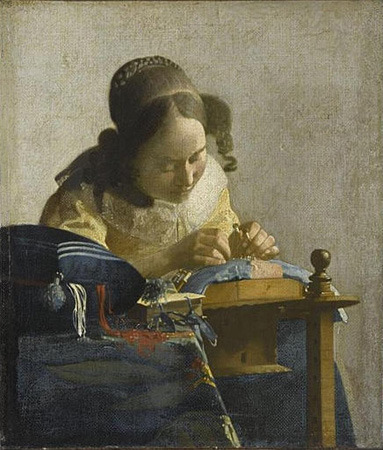
If you go to this page, you can hover over the image and get a commentary.
 Here is another post from the Met site. Specifically it talks about the works regarding Abraham Lincoln but we don't need to limit our responses there:
Here is another post from the Met site. Specifically it talks about the works regarding Abraham Lincoln but we don't need to limit our responses there:Questions posed by Harold Holzer
How is your favorite historical figure represented [in art]?
Do you enjoy learning about history through art? Can you trust an artist's interpretation?
 Another question from the Met:
Another question from the Met:Posed by Nadja Hansen
Which galleries or works would you share with a date? Are there any you might shy away from?
 First, I think I wouldn't want to share Manet's The Picnic on a first date with someone who is not familiar with art, especially the more famous pieces like those of Manet.
First, I think I wouldn't want to share Manet's The Picnic on a first date with someone who is not familiar with art, especially the more famous pieces like those of Manet.
I think it could lead to some inappropriate conversation.
On the other hand, if I really liked the person and they were somewhat familiar with art, I would love to tour the Rodin Museum in Paris. There I think I would share Rodin's The Kiss.
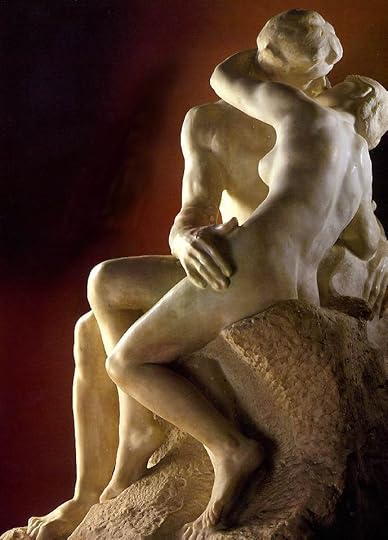
Very romantic!
 What is the most romantic work of art in your opinion?
What is the most romantic work of art in your opinion?Is looking at—and talking about—art a good way to get to know someone?
 Ed wrote: "Ed wrote: "Ed wrote: "As a rather subversive exercise, let me include a particular work (Don't peek at the image URL). And the question is--not is this the finest piece of art that you have ever s...but is this art...."
Ed wrote: "Ed wrote: "Ed wrote: "As a rather subversive exercise, let me include a particular work (Don't peek at the image URL). And the question is--not is this the finest piece of art that you have ever s...but is this art...."OK. I am not sure if the images are still there--I don't see them on the post. But they were done by an elephant and a chimpanzee.
 Heather wrote: "Another question from the Met: Posed by Nadja Hansen
Heather wrote: "Another question from the Met: Posed by Nadja HansenWhich galleries or works would you share with a date? Are there any you might shy away from? "
I would want to visit both well known artists and unknown artists, and be able to compare different works to each other so there would be a dialogue. It would pick from a variety of periods as well as mediums.
Compare a Pollock (all about the process, no concept)
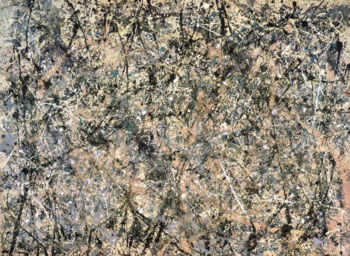
with a LeWitt (all about concept. Process done by others.)

Or a Picasso still life (multiple views, flat color)
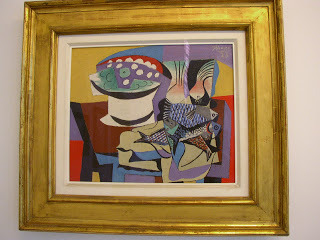
with a dutch still life by Willem Claesz Heda (realistic images, symbolism regarding Christian faith).
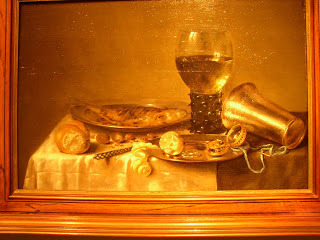
 Oh Carol, Carol. The Waltz is my absolute FAVORITE piece of all time. It truly is romantic. Of course, as I've said before, I like Claudel a lot more than Rodin, but I still love his work, too.
Oh Carol, Carol. The Waltz is my absolute FAVORITE piece of all time. It truly is romantic. Of course, as I've said before, I like Claudel a lot more than Rodin, but I still love his work, too.
 Monica wrote: I would not want to see any Scheile artwork with a date, or alone for that matter!
Monica wrote: I would not want to see any Scheile artwork with a date, or alone for that matter!I totally agree!
 Heather wrote:
How is your favorite historical figure represented [in art]?
Heather wrote:
How is your favorite historical figure represented [in art]?Do you enjoy learning about history through art? Can you trust an artist's interpretation?
I feel that the Self-Portraits of the artists are good representations of how the artist feels about him/her self. For example Van Gogh and Gauguin:

Van Gogh Self-Portrait
"In October 1888, van Gogh and Gauguin exchanged self-portraits that revealed a great deal about how they perceived themselves and wished to be seen by others. In van Gogh’s austere portrait, his gaunt face, short hair, and beard allude to his belief in a monastic lifestyle and refer to his role as a monk (bonze) or humble disciple to Gauguin. The contrast of blue and yellow in the portrait echoes the colors in van Gogh’s painting of the yellow house and "the symphony in blue and yellow" in his sunflowers series."
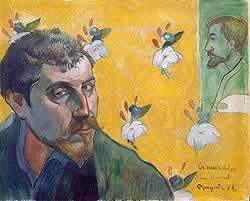
Gauiguin Self-Portrait
"Gauguin presented himself as an "outlaw" in his self-portrait, which specifically alludes to the noble character of Jean Valjean in Victor Hugo's novel Les Misérables. The bold lines of the figure and the vivid colors of the flowered wallpaper manifest Gauguin’s interest in "an abstract, symbolic style." Van Gogh, however, was disappointed when he received Gauguin’s Self-Portrait, believing that it expressed torment while failing to offer any hope or consolation. He even suggested to his brother Theo that the troubled Gauguin would benefit from a stay in the reinvigorating environment of Arles."
Art Institute of Chicago
http://www.artic.edu/aic/exhibitions/...
 A particular person in history represented in art does not come to mind. What DOES come to mind is Vasari's Corridor! http://www.museumsinflorence.com/muse...
A particular person in history represented in art does not come to mind. What DOES come to mind is Vasari's Corridor! http://www.museumsinflorence.com/muse...And there are surely other places like the National Portrait Gallery and the Archives of American Art (that picture of Jackson Pollock looked like it was lifted from a silent western-hysterical!) to peruse
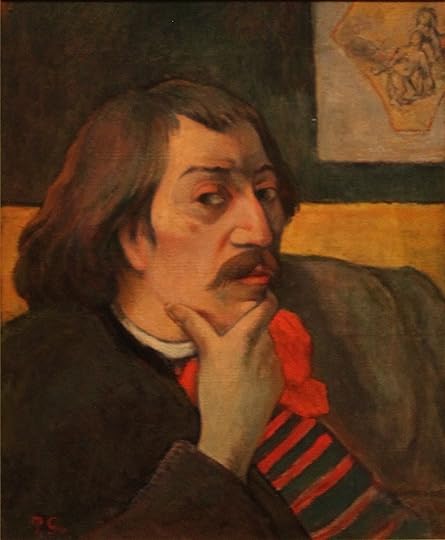
Imo we've got a better self portrait of Gauguin in Detroit.
 Monica wrote: "I can't find Ed's elephant chimpanzee url."
Monica wrote: "I can't find Ed's elephant chimpanzee url."Here's a drawing by Siri, a "damn talented elephant".
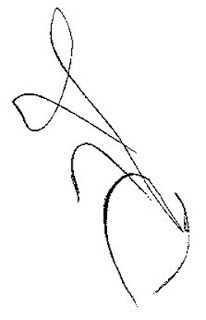
Pretty elegant. Self trained. This one is more reflective of what an elephant might do by itself with a pencil.
There are elephants who are trained to actually do paintings of elephants, you can see a lot of them on YouTube, but I suspect that a lot of the imagery is pushed on them by their trainers. elephant painting an elephant
OK, I find that there are a few videos of dogs and cats painting as well, but they seem less interesting....
 Here's a bio of Congo.
Here's a bio of Congo."Congo was born in 1954. He learned to draw near the age of two, beginning when zoologist Desmond Morris offered Congo a pencil.[2] Morris said, "He took [the pencil] and I placed a piece of card in front of him. This is how I recorded it at the time, 'Something strange was coming out of the end of the pencil. It was Congo's first line. It wandered a short way and then stopped. Would it happen again? Yes, it did, and again and again'."[2] Morris soon observed that the chimp would draw circles, and had a basic sense of composition in his drawings.[2] He also showed the ability of symmetrical consistency between two sides of a sketch; when Morris drew a shape at one side of a piece of paper, Congo would balance the structure by making marks on the other half of the paper.[2] Similarly, if a color on one side contained blue for example, he would add blue to the other side as well to keep balance.[1]
He soon began painting; the patterns he made were never distinguished, pictorial images, but usually of a vague "radiating fan pattern" in the abstract impressionism style.[2] Between the ages of two and four, he produced about 400 drawings and paintings.[3]..." you can read the rest here.

His art is collected. I think Picasso had one. And they are very valuable.
Whatever that means, he is said to have had an "artistic temperament."
"When a picture was taken away that he didn't consider complete, Congo would reportedly begin to scream and 'throw fits'....Also, if the ape considered one of his drawings to be finished, he would refuse to continue painting even if someone tried to persuade him to do so."
Also there is an interesting article Chimpanzees as Artists
I think it might make sense that with animals that have some level of sentience and a method of grasping and holding you might have some level of aesthetic production.
It's just a little disturbing. :)
 Interesting how we just read a bit about Gertrude Stein. Here is another question from the Met:
Interesting how we just read a bit about Gertrude Stein. Here is another question from the Met:Gertrude Stein told Ernest Hemingway not to buy clothes, but to save his money and buy art. If you had the resources, would you follow Stein's advice?
 I can easily answer this question. I definitely would take Stein's advice. Art most likely would only increase in value, whereas clothes get worn out and become out of style, etc. There is no comparison...buy art!
I can easily answer this question. I definitely would take Stein's advice. Art most likely would only increase in value, whereas clothes get worn out and become out of style, etc. There is no comparison...buy art!
 Yes, but I really like clothes!!!I I don't follow Steins advice, haven't all my life...just bought prints to frame, really. I've been a clothes horse. And have lots of beautiful things, not much that is going to make me much $$$. Can't we have both??
Yes, but I really like clothes!!!I I don't follow Steins advice, haven't all my life...just bought prints to frame, really. I've been a clothes horse. And have lots of beautiful things, not much that is going to make me much $$$. Can't we have both??
 Heather wrote: "I can easily answer this question. I definitely would take Stein's advice. Art most likely would only increase in value, whereas clothes get worn out and become out of style, etc. There is no compa..."
Heather wrote: "I can easily answer this question. I definitely would take Stein's advice. Art most likely would only increase in value, whereas clothes get worn out and become out of style, etc. There is no compa..."Stein has been a topic in my group- most feel she is quite over-rated- except for her book about her companion
 That's true, Rick. Maybe she is overrated. I read your quote in your group by her about the cats...I like it!
That's true, Rick. Maybe she is overrated. I read your quote in your group by her about the cats...I like it!
 If I added up all the money I've spent on clothes, I could buy some nice art. But clothes money goes out in dribs and drabs instead of in one big bunch, so the expense doesn't register as much.
If I added up all the money I've spent on clothes, I could buy some nice art. But clothes money goes out in dribs and drabs instead of in one big bunch, so the expense doesn't register as much.Besides, I don't have enough walls for the art I already own. Some bought, some traded for with fellow artists, some done by yours truly.
Books mentioned in this topic
Leaving Van Gogh (other topics)Point and Line to Plane (other topics)
Michelangelo and the Pope's Ceiling (other topics)


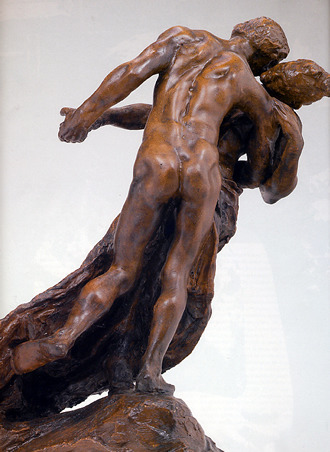






Carol, there's not really a lot to interpret there. It's not terribly sophisticated. It seems more than anything else to be the work of a high school student who just might be a little overzealous (I only say that because he tried to pull a similar stunt in shop class, apparently).